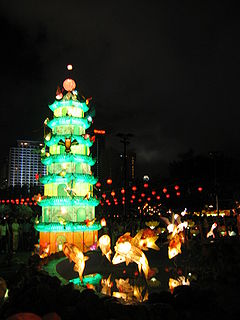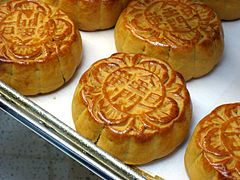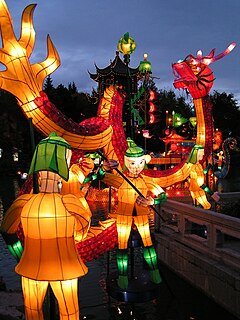Mid-Autumn Festival
From Wikipedia, the free encyclopedia
Mid-Autumn Festival
|
|||||||||||||||
|---|---|---|---|---|---|---|---|---|---|---|---|---|---|---|---|
| Chinese name | |||||||||||||||
| Traditional Chinese: | 中秋節 | ||||||||||||||
| Simplified Chinese: | 中秋节 | ||||||||||||||
|
|||||||||||||||
| Min name | |||||||||||||||
| Chinese: | 八月節 | ||||||||||||||
|
|||||||||||||||
| Vietnamese name | |||||||||||||||
| Quốc ngữ: | Tết Trung Thu | ||||||||||||||
| Chữ nôm: | 節中秋 | ||||||||||||||



The Mid-Autumn Festival, also known as the Moon Festival, or in Chinese, Zhongqiu Jie (traditional Chinese: 中秋節), is a popular harvest festival celebrated by Chinese people and Vietnamese people (even though they celebrate it differently), dating back over 3,000 years to moon worship in China's Shang Dynasty.[1][2] It was first called Zhongqiu Jie (literally "Mid-Autumn Festival") in the Zhou Dynasty.[3] In Malaysia and Singapore, it is also sometimes referred to as the Lantern Festival or Mooncake Festival.
The Mid-Autumn Festival is held on the 15th day of the eighth month in the Chinese calendar, which is usually around mid or late September in the Gregorian calendar. It is a date that parallels the autumn and spring Equinoxes of the solar calendar, when the moon is supposedly at its fullest and roundest. The traditional food of this festival is the mooncake, of which there are many different varieties.
The Mid-Autumn Festival is one of the two most important holidays in the Chinese calendar, the other being the Chinese New Year, and is a legal holiday in several countries. Farmers celebrate the end of the summer harvesting season on this date. Traditionally, on this day, Chinese family members and friends will gather to admire the bright mid-autumn harvest moon, and eat moon cakes and pomeloes together. Accompanying the celebration, there are additional cultural or regional customs, such as:
- Eating moon cakes outside under the moon
- Putting pomelo rinds on one's head
- Carrying brightly lit lanterns, lighting lanterns on towers, floating sky lanterns
- Burning incense in reverence to deities including Chang'e (simplified Chinese: 嫦娥; traditional Chinese: 嫦娥; pinyin: cháng'é)
- Planting Mid-Autumn trees
- Collecting dandelion leaves and distributing them evenly among family members
- Fire Dragon Dances
Shops selling mooncakes, before the festival, often display pictures of Chang'e floating to the moon.
Contents |
[edit] Stories of the Mid-Autumn Festival
[edit] Houyi and Chang'e
While English speakers may talk about the “man on the moon”, the Chinese talk about the “woman on the moon”. The story of the fateful night when Chang'e was lifted up to the moon, familiar to most Chinese citizens, is a favorite subject of poets. Unlike many lunar deities in other cultures who personify the moon, Chang'e lives on the moon. Tradition places Houyi and Chang'e around 2170 BC, in the reign of the legendary Emperor Yao, shortly after that of Huang Di.
There are so many variations and adaptations of the Chang'e legend that one can become overwhelmed and utterly confused. However, most legends about Chang'e in Chinese mythology involve some variation of the following elements: Houyi, the Archer, Chang'e, the mythical Moon Goddess of Immortality; an emperor, either benevolent or malevolent; an elixir of life; and the Moon:
[edit] Houyi, the Archer
| It has been suggested that this article or section be merged into Houyi. (Discuss) |
There are at least 6 variations to this story where Houyi was an archer.
Version 1: A long, long time ago, a terrible drought plagued the earth. Ten suns burned fiercely in the sky like smoldering volcanoes. The trees and grass were scorched. The land was cracked and parched, and rivers were dried. Many people died of hunger and thirst.
The King of Heaven sent Hou Yi down to the earth to help. When Hou Yi arrived, he took out his red bow and white arrows and shot down nine suns one after another. The weather immediately turned cooler. Heavy rains filled the rivers with fresh water and the grass and trees turned green. Life was restored and humanity was saved.
One day, a charming young woman Chang'er made her way home from a stream, holding a bamboo container. A young man came forward, asking for a drink. When she saw the red bow and white arrows hanging round his belt, Chang'er realized that he was their savior, Hou Yi. Inviting him to drink, Chang'er plucked a beautiful flower and gave it to him as a token of respect. Hou Yi, in turn, selected a beautiful silver fox fur as his gift for her. This meeting kindled the spark of their love. And soon after that, they got married.
A mortal's life is limited, of course. So in order to enjoy his happy life with Chang'er forever, Hou Yi decided to look for an elixir of life. He went to the Kunlun Mountains where the Western Queen Mother lived.
Out of respect for the good deeds he had done, the Western Queen Mother rewarded Hou Yi with the elixir, a fine powder made from kernels of fruit which grew on the tree of eternity. At the same time, she told him that if he and his wife shared the elixir, they would both enjoy eternal life; but if only one of them took it, that one would ascend to Heaven and become immortal.
Hou Yi returned home and told his wife all that had happened and they decided to drink the elixir together on the 15th day of the eighth lunar month when the moon was full and bright.
A wicked and merciless man named Feng Meng overheard their plan. He wished Hou Yi an early death so that he could drink the elixir himself and become immortal. His opportunity finally arrived. One day, when the full moon is rising, Hou Yi was on his way home from hunting. Feng Meng killed him. The murderer then ran to Hou Yi's home and forced Chang'er to give him the elixir. Without hesitating, Chang'er picked up the elixir and drank it all.
Overcome with grief, Chang'er rushed to her dead husband's side, weeping bitterly. Soon the elixir began to have its effect and Chang'er felt herself being lifted towards Heaven.
Chang'er decided to live on the moon because it was the nearest to the earth. There she lived a simple and contented life. Even though she was in Heaven, her heart remained in the world of mortals. Never did she forget the deep love she had for Hou Yi and the love she felt for the people who had shared their sadness and happiness.
Version 2: Houyi was an immortal, while Chang'e was a beautiful young girl, working in the Jade Emperor's (Emperor of Heaven) (玉帝 pinyin:yùdì) Palace as the attendant to the Queen Mother of the West (wife of the Jade Emperor), just before her marriage. One day, Houyi aroused the jealousy of the other immortals, who then slandered him before the Jade Emperor. Houyi and his wife, Chang'e, were subsequently banished from heaven, and forced to live by hunting on earth. He became a famous archer.
Now at this time, there were 10 suns, in the form of Three-legged birds, residing in a mulberry tree in the eastern sea; each day one of the sun birds would have to travel around the world on a carriage, driven by Xihe (deity) the 'mother' of the suns. One day, all 10 of the suns circled together, causing the earth to burn. Emperor Yao, the Emperor of China, commanded Houyi to shoot down all but one of the suns. Upon the completion of his task, the Emperor rewarded Houyi with a pill that granted eternal life, and advised him: "Make no haste to swallow this pill; first prepare yourself with prayer and fasting for a year".[4] Houyi took the pill home and hid it under a rafter, while he began healing his spirit. While Houyi was healing his spirit, Houyi was summoned again by the emperor. Chang'e, noticing a white beam of light beckoning from the rafters, discovered the pill, which she swallowed. Immediately, she found that she could fly. At that moment, Houyi returned home, and, realizing what had happened, began to reprimand her. Chang'e flew out the window into the sky.[4]
With a bow in hand, Houyi sped after her, and the pursuit continued halfway across the heavens. Finally, Houyi had to return to the Earth because of the force of the wind. Chang'e reached the moon, and breathless, she coughed. Part of the pill fell out from her mouth.[4] Now, the hare was already on the moon, and Chang'e commanded the animal to make another pill from it, so that she could return to earth to her husband.
As of today, the hare is still pounding herbs, trying to make the pill. As for Houyi, he built himself a palace in the sun as "Yang" (the male principle), with Chang'e as "Yin" (the female principle). Once a year, on the 15th day of the full moon, Houyi visits his wife. That is why, that night, the moon is full and beautiful.[4]
This description appears in written form in two Western Han dynasty (206 BCE-24 CE) collections; Shan Hai Jing, the Classic of the Mountains and Seas and Huainanzi, a philosophical classic.[5]
Version 3: The earth once had ten suns circling over it, each taking turn to illuminate the earth. One day, however, all ten suns appeared together, scorching the earth with their heat. Houyi, a strong and tyrannical archer, saved the earth by shooting down nine of the suns. He eventually became King, but grew to become a despot.
One day, Houyi stole the elixir of life from a goddess. However, his beautiful wife, Chang'e, drank it in order to save the people from her husband’s tyrannical rule. After drinking it, she found herself floating, and flew to the moon. Houyi loved his divinely beautiful wife so much, he did not shoot down the moon.
Version 4: Another version, however, had it that Chang'e and Houyi were immortals living in heaven. One day, the ten sons of the Jade Emperor transformed into ten suns, causing the earth to scorch. Having failed to order his sons to stop ruining the earth, the Jade Emperor summoned Houyi for help. Houyi, using his legendary archery skills, shot down nine of the sons, but spared one son to be the sun. The Jade Emperor was obviously displeased with Houyi’s solution to save the earth. As punishment, he banished Houyi and Chang'e to live as mere mortals on earth.
Seeing that Chang'e felt extremely miserable over her loss of immortality, Houyi decided to journey on a long, perilous quest to find the pill of immortality so that the couple could be immortals again. At the end of his quest, he met the Queen Mother of the West, who agreed to give him the pill, but warned him that each person would only need half a pill to regain immortality.
Houyi brought the pill home and stored it in a case. He warned Chang'e not to open the case, and then left home for a while. Like Pandora in Greek mythology, Chang'e became curious. She opened up the case and found the pill, just as Houyi was returning home. Nervous that Houyi would catch her, discovering the contents of the case, she accidentally swallowed the entire pill, and started to float into the sky because of the overdose. Although Houyi wanted to shoot her in order to prevent her from floating further, he could not bear to aim the arrow at her. Chang'e kept on floating until she landed on the moon.
While she became lonely on the moon without her husband, she did have company. A jade rabbit, who manufactured elixirs, also lived on the moon.
Version 5: In a popular school version, Houyi was a lazy boy who did nothing but to practice his archery. He practiced day and night until he became the greatest archer in the world. One day, the ten suns all assembled around the earth. Their presence destroyed all vegetation, and hundreds of thousands were perishing. The emperor, who was desperate, offered his crown to anyone who could shoot down the suns. Houyi answered his call. He shot down nine of the suns, and as he pulled his bow to shoot the last one, the emperor stopped him. Saying the earth must have one sun. Houyi then became the emperor. He was pampered to the extent that he wanted to be emperor forever. He called his advisors to look for a way to make him immortal. His advisors found a way. They found a recipe for the Pill of Immortality. It required 100 adolescent boys to be ground into a biscuit like a pill. Every night he was supposed to grind one boy. On the hundredth night, his wife Chang'e could not bear to watch her husband become the tyrannical dictator for eternity. She prayed to Xi Wang Mu for help. She stole the pill, with Houyi shooting arrows at her, and flew to the moon grabbing a rabbit to keep her company.So the Chinese say that if you look up at the moon to this day you can sometimes see a rabbit making moon cakes.
[edit] The Hare - Jade Rabbit

According to tradition, the Jade Rabbit pounds medicine, together with the lady, Chang'er, for the gods. Others say that the Jade Rabbit is a shape, assumed by Chang'e herself. You may find that the dark areas to the top of the full moon may be construed as the figure of a rabbit. The animal's ears point to the upper right, while at the left are two large circular areas, representing its head and body. [6]
In this legend, three fairy sages transformed themselves into pitiful old men, and begged for food from a fox, a monkey, and a hare. The fox and the monkey both had food to give to the old men, but the hare, empty-handed, jumped into a blazing fire to offer his own flesh instead. The sages were so touched by the hare's sacrifice and act of kindness that they let him live in the Moon Palace, where he became the "Jade Rabbit".
[edit] Overthrow of Mongol rule
According to a widespread folk tale (not necessarily supported by historical records), the Mid-Autumn Festival commemorates an uprising in China against the Mongol rulers of the Yuan Dynasty (1280–1368) in the 14th century.[7] As group gatherings were banned, it was impossible to make plans for a rebellion.[7] Noting that the Mongols did not eat mooncakes, Liu Bowen (劉伯溫) of Zhejiang Province, advisor to the Chinese rebel leader Zhu Yuanzhang, came up with the idea of timing the rebellion to coincide with the Mid-Autumn Festival. He sought permission to distribute thousands of moon cakes to the Chinese residents in the city to bless the longevity of the Mongol emperor. Inside each cake, however, was inserted a piece of paper with the message: "Kill the Mongols on the 15th day of the 8th month" (八月十五殺韃子).[7] On the night of the Moon Festival, the rebels successfully attacked and overthrew the government. What followed was the establishment of the Ming Dynasty (1368-1644), under Zhu. Henceforth, the Mid-Autumn Festival was celebrated with moon cakes on a national level.
[edit] Vietnamese version
The Mid-Autumn festival is named "Tết Trung Thu" in Vietnamese.
The Vietnamese version of the holiday recounts the legend of Cuội, whose wife accidentally urinated on a sacred banyan tree, taking him with it to the Moon. Every year, on the mid-autumn festival, children light lanterns and participate in a procession to show Cuội the way to Earth.[8]
In Vietnam, Mooncakes are typically square rather than round, though round ones do exist. Besides the indigenous tale of the banyan tree, other legends are widely told including the story of the Moon Lady, and the story of the carp who wanted to become a dragon.[8]
One important event before and during Vietnamese Mid-Autumn Festival are lion dances. The dances are performed by both non-professional children group and trained professional groups. Lion dance groups perform on the streets go to houses asking for performing. If accepted by the host, "the lion" will come in and start dancing as a wish of luck and fortune and the host gives back lucky money to show thankfulness.
[edit] Dates
The moon festival will occur on these days in coming years:[citation needed]
- 2008: September 14
- 2009: October 3
- 2010: September 22
- 2011: September 12
- 2012: September 30
- 2013: September 19
- 2014: September 8
- 2015: September 27
- 2016: September 15
- 2017: October 4
- 2018: September 24
[edit] References
- ^ Chinavoc.com article on the Mid-Autumn festival
- ^ Article on Tsukimi explaining history of moon viewing custom
- ^ Chinese language article about references to the Mid Autumn festival in ancient Chinese text - chinapage.com
- ^ a b c d Chinatown.com.au
- ^ Shanghai me
- ^ Chinatown Online - your guide to all things Chinese
- ^ a b c Examination of the legend against the historical backdrop of mongol dynasty
- ^ a b familyculture.com tettrungthu
http://www.chinaculture.org/gb/en_chinaway/2003-09/24/content_28099.htm
[edit] See also
- Chinese New Year
- Chinese holidays
- List of Harvest Festivals
- Tidal bore of Qiantang River
- Chuseok, Korean harvest festival celebrated on the same day as the Mid-Autumn Festival
- Tsukimi, the Japanese Mid-Autumn Festival
[edit] External links
| Wikimedia Commons has media related to: Mid-Autumn Festival |
- Did the Chinese use mooncakes to overthrow mongols?
- Autumn Moon Festival in San Francisco Chinatown
- - Autumn Moon Festival in Australia
- chinatown.com.au
- The Stories of the Chinese Moon Festival
- Origin of Mid-Autumn Festival
- Têt Trung Thu
- Tet Trung Thu and Mooncake Madness
- Mooncake Recipes
- More photos of Mid-Autumn Festival
- Moon Festival Greeting Cards



